Internships at NIBIB can open doors to new perspectives on research, career opportunities and much more.
This summer, doors opened for more than 20 university students, recruited by the Biomedical Engineering Summer Internship Program (BESIP) and Center for Biomedical Engineering Technology Acceleration (BETA Center), who got the chance to get hands-on with cutting-edge biomedical technology on NIH campus.
The interns, with the support of the Office of Intramural Training and Education (OITE), conducted research under the direction of top-flight experts from institutions across NIH. Here’s a brief look at what some of the interns at NIBIB were up to and what the experience meant to them:
Olivia Ernst
Ernst is a rising biomedical engineering senior at Rochester Institute of Technology with a strong interest in disease research and a passion for supporting women in STEM, demonstrated by her role as president of her school’s chapter of the Society of Women Engineers.
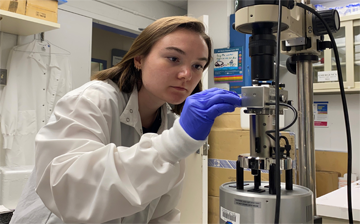
This summer, she focused on the malaria-causing parasites Plasmodium falciparum and Plasmodium vivax. With hopes of identifying opportunities for improved treatments, she used various microscopy techniques to examine the primary component of malaria vaccines, a surface protein of the parasite known as the circumsporozoite protein, as well as the behavior of the parasite itself.
Ernst has been set on studying diseases as a career, but having gotten a glimpse of the real thing, she’s more eager than before to pursue a Ph.D. As she strives for her goals, she aspires to encourage other women to reach theirs.
Joseph Editone III
An incoming junior at Prairie View A&M University studying biology, Editone seeks to one day practice surgery, while finding ways to improve the process.
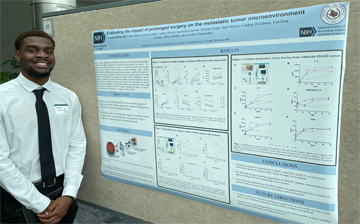
Editone spent his time at NIH working under the guidance of both physicians and engineers. For one research project, he studied the effects of extended surgical procedures on patients to potentially identify ways to improve their recovery. He also worked to improve a system designed to sustain excised organs, for the purpose of testing cancer treatments.
After working in a multidisciplinary research environment, Editone’s perception of the world of medicine has expanded greatly. He plans to continue on a pre-med track but will keep his eyes open for further research opportunities at NIH.
Adia Drayton
Drayton is an incoming senior in biomedical engineering at North Carolina A&T University, with interests in cancer research, tissue engineering, and teaching.
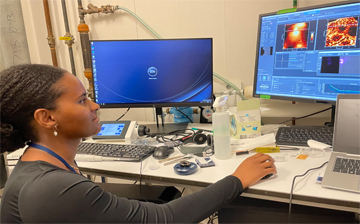
She spent this summer at NIBIB studying pancreatic cancer cells using atomic force microscopy. The mechanical properties of tumors, which are often tougher than healthy tissue, could hold important clues as to whether the masses are cancerous and if so, how aggressive. Drayton’s project centered on quantifying those differences, which could become important biomarkers for new cancer diagnostics.
Drayton seeks to complete her undergraduate education in the next year and will keep her eyes peeled for post-baccalaureate opportunities at NIH afterward. Her longer-term aspirations are to teach students as a university professor.
Jarrod Burns
Burns is a rising junior studying biology at Gallaudet University, a school that serves deaf and hard of hearing students. He is eager to pursue a career working at the lab bench in biomedical science and, as a local to the Washington metro area, has had an eye out for opportunities at the NIH.
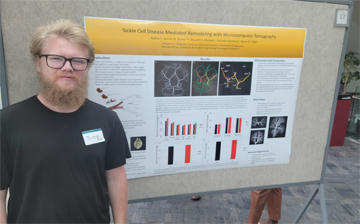
Burns’ research project in NIBIB was centered on sickle cell disease — a group of rare red blood cell disorders that can cause stroke and other serious health complications. To better grasp how these disorders damage cerebral arteries and unveil opportunities for new treatments, he used micro computed tomography (CT) scans to assess and compare arterial traits of mice with either mild or severe versions of the disease.
After a successful first outing in the lab, Burns feels motivated to seek a Ph.D. after undergrad, taking further steps toward a career as a research scientist.
Aasim Hawa
Hawa is an incoming senior at the University of Rochester, majoring in biomedical engineering on a pre-med track.
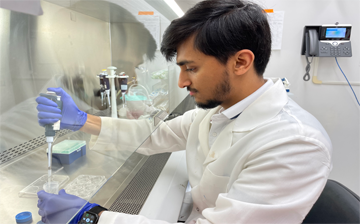
At NIBIB, Hawa has worked on improving a device, known as a bioreactor, that can sustain 3D clusters of adrenocortical carcinoma cells and replicate the low-oxygen conditions found in real tumors, which may cause their drug resistance. The bioreactor could potentially serve as a realistic testbed for experimental cancer therapeutics.
Following this summer internship, Hawa aims to enter medical school, eventually becoming a practicing physician while still actively engaging in research into new medical technologies.
Paige Rudy
A rising senior in biomedical engineering at the University of Arizona, Rudy is most curious about tissue engineering. She enjoys sparking the same curiosity in others by giving tours and participating in recruitment events as an engineering ambassador at school.
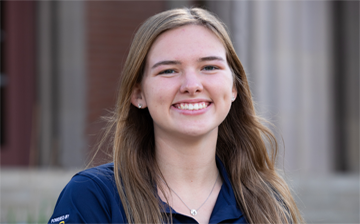
Her labmates and mentor this summer at NIBIB sparked her curiosity in a new subject.
While she had previous experience with tissue-engineered scaffolds, her project had her investigate how particular immune cells called dendritic cells — which are responsible for coordinating immune responses — reacted to scaffolds in injured tissue. The findings about our body’s response could feed back into how we design scaffolds and other medical implants.
Rudy plans to apply to join Ph.D. programs this fall. In graduate school and onwards, she hopes to study tissue engineering and put her new appreciation of the immune response to use, sharing her excitement for her research with others along the way.
